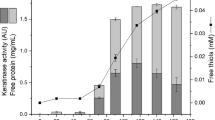Abstract
An aminopeptidase gene fragment was isolated from a keratin-degrading strain, Streptomyces fradiae var. k11, by PCR amplification using a degenerate primer set designed based on the partial amino acid sequence of the native enzyme. The gene, designated sfap, encoded a polypeptide of 461 amino acids comprised of three domains: a signal peptide, a mature region, and a C-terminal propeptide. The aminopeptidase, SFAP, had highest amino acid sequence identity (79%) with a putative aminopeptidase from Streptomyces griseus subsp. griseus NBRC 13350. The gene with and without C-terminal propeptide was successfully overexpressed in Escherichia coli BL21 (DE3), and the gene without C-terminal propeptide encoded a functional enzyme. Purified recombinant SFAP exhibited optimal activity at pH 8.0 and 60 °C, and retained >60% peak activity over a broad range of temperature. The enzyme was thermal and pH stable, and showed metalloprotease characteristics, which was inhibited by EDTA but activated by Ca2+ and Co2+. This is the first study to report the gene cloning and expression of a leucine aminopeptidase from S. fradiae.




Similar content being viewed by others
References
Jankiewicz, U., & Bielawski, W. (2003). Acta Microbiologica Polonica, 52, 217–231.
Gonzales, T., & Robert-Baudouy, J. (1996). FEMS Microbiology Reviews, 18, 319–344. doi:10.1111/j.1574-6976.1996.tb00247.x.
Sanderink, G. J., Artur, Y., & Siest, G. (1988). Journal of Clinical Chemistry and Clinical Biochemistry. Zeitschrift fur Klinische Chemie und Klinische Biochemie, 26, 795–807.
Taylor, A. (1993). Trends in Biochemical Sciences, 18, 167–172.
Taylor, A. (1993). The FASEB Journal: official publication of the Federation of American Societies for Experimental Biology, 7, 290–298.
Sanglier, J. J., Haag, H., Huck, T. A., & Fehr, T. (1993). Research in Microbiology, 144, 633–642. doi:10.1016/0923-2508(93)90066-B.
Chater, K. F. (1989). Trends in genetics. TIG, 5, 372–377.
Arima, J., Iwabuchi, M., & Hatanaka, T. (2004). Biochemical and Biophysical Research Communications, 317, 531–538. doi:10.1016/j.bbrc.2004.03.082.
Ni, S. X., Cossar, D., Man, A., Norek, K., Miller, D., Kearse, C., et al. (2003). Protein Expression and Purification, 30, 62–68. doi:10.1016/S1046-5928(03)00070-6.
Arima, J., Iwabuchi, M., & Hatanaka, T. (2006). Applied Microbiology and Biotechnology, 70, 541–547. doi:10.1007/s00253-005-0105-8.
Kim, I. S., Kim, Y. B., & Lee, K. J. (1998). The Biochemical Journal, 331, 539–545.
Morihara, K., Oka, T., & Tsuzuki, H. (1967). Biochimica et Biophysica Acta, 139, 382–397.
Li, J., Shi, P., Zhang, W., Han, X., Xu, L., Zhang, H., et al. (2005). Chinese Journal of Biotechnology, 21, 782–788.
Laemmli, U. K. (1970). Nature, 227, 680–685. doi:10.1038/227680a0.
Prescot, J. M., & Wilkes, S. H. (1976). Methods in Enzymology, 45, 530–543. doi:10.1016/S0076-6879(76)45047-4.
Suzuki, Y., Tsujimoto, Y., Matsui, H., & Watanabe, K. (2006). Journal of Bioscience and Bioengineering, 102, 73–81. doi:10.1263/jbb.102.73.
Meng, K., Li, J., Cao, Y., Shi, P., Wu, B., Han, X., et al. (2007). Canadian Journal of Microbiology, 53, 186–195. doi:10.1139/W06-122.
Li, J., Shi, P., Han, X., Meng, K., Yang, P., Wang, Y., et al. (2007). Protein Expression and Purification, 54, 79–86. doi:10.1016/j.pep.2007.02.012.
Wandersman, C. (1989). Molecular Microbiology, 3, 1825–1831. doi:10.1111/j.1365-2958.1989.tb00169.x.
Tang, B., Nirasawa, S., Kitaoka, M., & Hayashi, K. (2002). Biochemical and Biophysical Research Communications, 296, 78–84. doi:10.1016/S0006-291X(02)00838-0.
Tang, B., Nirasawa, S., Kitaoka, M., & Hayashi, K. (2002). Biochimica et Biophysica Acta, 1596, 16–27.
Zhang, Z., Nirasawa, S., Nakajima, Y., Yoshida, M., & Hayashi, K. (2000). The Biochemical Journal, 350, 671–676. doi:10.1042/0264-6021:3500671.
Nagy, V., Nampoothiri, K. M., Pandey, A., Rahulan, R., & Szakacs, G. (2008). Journal of Applied Microbiology, 104, 380–387.
Spungin, A., & Blumberg, S. (1989). European Journal of Biochemistry, 183, 471–477. doi:10.1111/j.1432-1033.1989.tb14952.x.
Ben-Meir, D., Spungin, A., Ashkenazi, R., & Blumberg, S. (1993). European Journal of Biochemistry, 212, 107–112. doi:10.1111/j.1432-1033.1993.tb17639.x.
Arima, J., Uesugi, Y., Uraji, M., Yatsushiro, S., Tsuboi, S., Iwabuchi, M., et al. (2006). The Journal of Biological Chemistry, 281, 5885–5894. doi:10.1074/jbc.M509025200.
Arima, J., Uesugi, Y., Uraji, M., Iwabuchi, M., & Hatanaka, T. (2006). FEBS Letters, 580, 912–917. doi:10.1016/j.febslet.2006.01.014.
Lin, L., Park, H. I., & Ming, L. (1997). Journal of Biological Inorganic Chemistry: JBIC: a publication of the Society of Biological Inorganic Chemistry, 2, 744–749.
Acknowledgements
This work was supported by the Chinese National High Technology Research and Development Program (863 Program, Grant No. 2007AA100601) and National Key Technology R&D Program of China (No. 2006BAD12B05-03).
Author information
Authors and Affiliations
Corresponding author
Rights and permissions
About this article
Cite this article
Wu, B., Shi, P., Li, J. et al. A New Aminopeptidase from the Keratin-Degrading Strain Streptomyces fradiae var. k11. Appl Biochem Biotechnol 160, 730–739 (2010). https://doi.org/10.1007/s12010-009-8537-8
Received:
Accepted:
Published:
Issue Date:
DOI: https://doi.org/10.1007/s12010-009-8537-8




